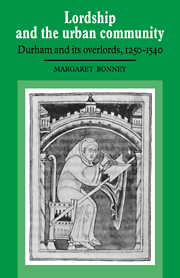Book contents
- Frontmatter
- Contents
- Acknowledgements
- List of abbreviations
- INTRODUCTION
- 1 URBAN ORIGINS: THE GROWTH AND DEVELOPMENT OF DURHAM TO 1250
- 2 THE URBAN LANDSCAPE OF DURHAM 1250–1540
- 3 DURHAM'S MEDIEVAL BUILDINGS
- 4 LANDLORD AND TENANTS: THE ECONOMIC RELATIONSHIP BETWEEN DURHAM PRIORY AND ITS URBAN TENANTS IN THE LATER MIDDLE AGES
- 5 TRADES AND OCCUPATIONS
- 6 LORDSHIP IN ACTION: THE MAINTENANCE OF LAW AND ORDER IN LATE-MEDIEVAL DURHAM
- CONCLUSION: LORDSHIP AND COMMUNITY: THE RELATIONS BETWEEN DURHAM AND ITS ECCLESIASTICAL OVERLORDS IN THE LATER MIDDLE AGES
- Appendix 1 Maps and plans of Durham
- Appendix 2 Tables
- Appendix 3 The dates of the bishops of Durham from 995 to the Dissolution
- Appendix 4 The obedientiaries of Durham Priory
- Appendix 5 The Durham courts
- Bibliography
- Index
4 - LANDLORD AND TENANTS: THE ECONOMIC RELATIONSHIP BETWEEN DURHAM PRIORY AND ITS URBAN TENANTS IN THE LATER MIDDLE AGES
Published online by Cambridge University Press: 06 January 2010
- Frontmatter
- Contents
- Acknowledgements
- List of abbreviations
- INTRODUCTION
- 1 URBAN ORIGINS: THE GROWTH AND DEVELOPMENT OF DURHAM TO 1250
- 2 THE URBAN LANDSCAPE OF DURHAM 1250–1540
- 3 DURHAM'S MEDIEVAL BUILDINGS
- 4 LANDLORD AND TENANTS: THE ECONOMIC RELATIONSHIP BETWEEN DURHAM PRIORY AND ITS URBAN TENANTS IN THE LATER MIDDLE AGES
- 5 TRADES AND OCCUPATIONS
- 6 LORDSHIP IN ACTION: THE MAINTENANCE OF LAW AND ORDER IN LATE-MEDIEVAL DURHAM
- CONCLUSION: LORDSHIP AND COMMUNITY: THE RELATIONS BETWEEN DURHAM AND ITS ECCLESIASTICAL OVERLORDS IN THE LATER MIDDLE AGES
- Appendix 1 Maps and plans of Durham
- Appendix 2 Tables
- Appendix 3 The dates of the bishops of Durham from 995 to the Dissolution
- Appendix 4 The obedientiaries of Durham Priory
- Appendix 5 The Durham courts
- Bibliography
- Index
Summary
Durham Cathedral Priory had a dominant interest both as landlord and landowner in the town which surrounded the peninsula. No less than three of Durham's five boroughs were under the direct overlordship of its obedientiaries: Old and New Elvet were managed by the hostillar and the Old Borough was administered by the sacrist after 1423. Landmale, or ground rents, as well as the profits of the borough courts, went to these officers automatically to help them finance their duties within the priory. By 1500 the priory had succeeded in becoming the leading landlord in these parts of the urban area by its acquisition of many of the freeholds of properties, and in addition, several valuable tenements elsewhere, for example in the Bailey, Clayport and St Giles, had come into priory hands. The management as well as the revenues of this large urban estate were subdivided among the priory obedientiaries: in all, eight obedientiaries had property-holding interests in Durham from which they derived what proved to be a somewhat fluctuating income. Set against this impressive priory stake in the Durham property-market, the bishop's overlordship of only one borough in the later middle ages, the Bishop's Borough, looks poor indeed, although, like the priory, the bishop held valuable properties in other boroughs as well. But it must be borne in mind that the Bishop's Borough was the most prosperous part of Durham at all periods; it contained the one marketing area for the whole town and so, in addition to court profits, it yielded a considerable income from tolls for its overlord.
- Type
- Chapter
- Information
- Lordship and the Urban CommunityDurham and its Overlords, 1250–1540, pp. 104 - 144Publisher: Cambridge University PressPrint publication year: 1990



